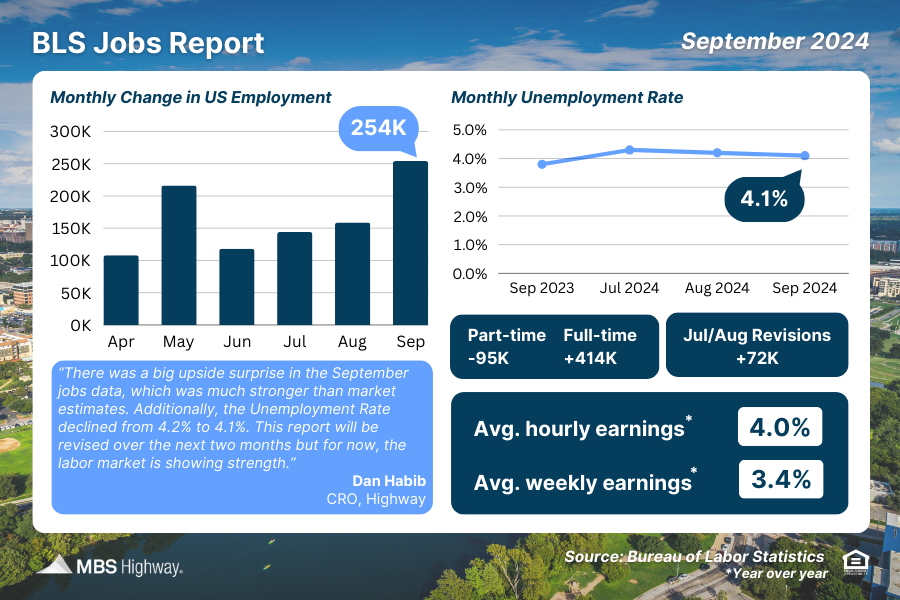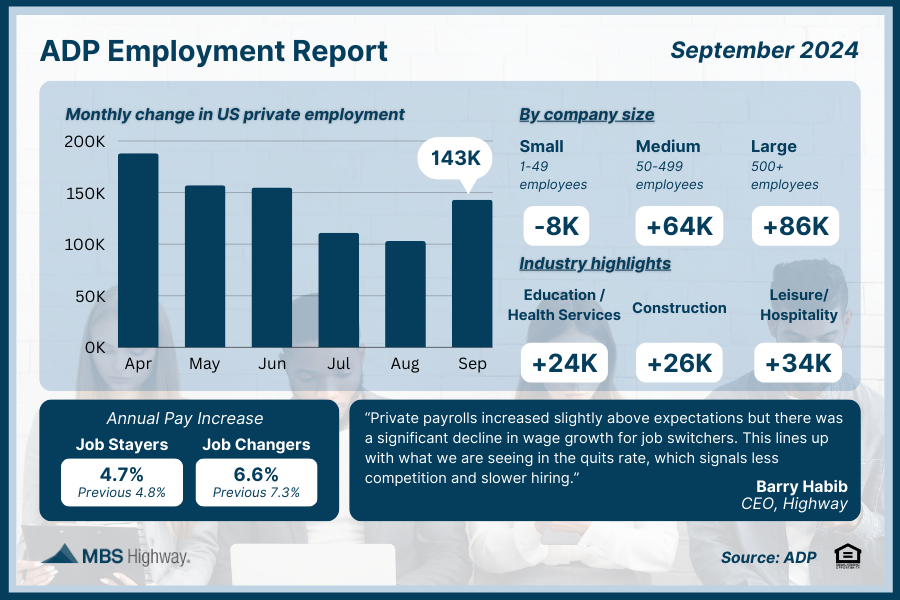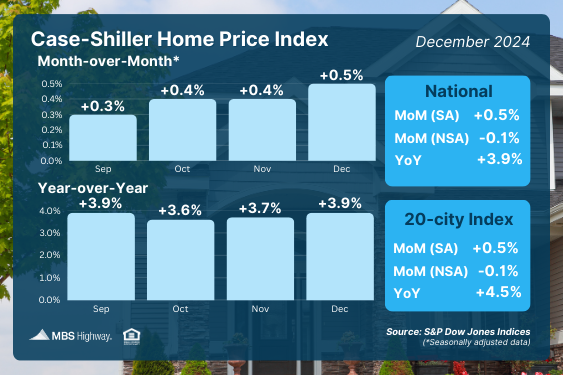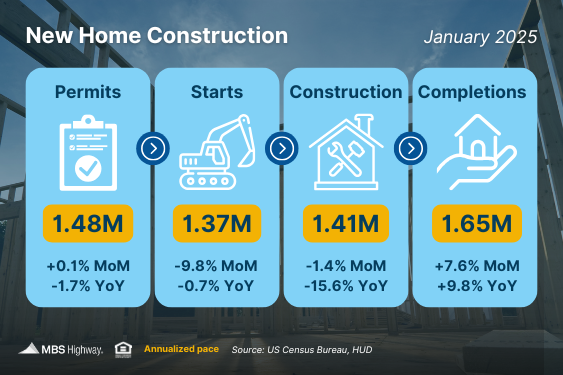When it comes to getting a mortgage, there’s no shortage of misinformation. Many homebuyers, especially…
Week of September 30, 2024 in Review
Job growth in September was stronger than expected, while the unemployment rate ticked lower. Here are last week’s headlines:
-Big Upside Jobs Surprise
-Private Sector Job Growth Rebounds, Wages Moderate
-Uptick in August’s Job Openings Not Whole Story
-Is Gig Economy Impacting Jobless Claims?
-Annual Home Price Growth Still Strong
The Bureau of Labor Statistics (BLS) reported that there were 254,000 jobs created in September, which was well above estimates of 140,000. Positive revisions to July and August also added 72,000 jobs to those months combined. The unemployment rate fell from 4.2% to 4.1%.
What’s the bottom line? This report had a different tone than the softer labor sector data we’ve seen in recent months, as it showed strength on multiple fronts. In addition to the overall beat in job growth, the number of full-time workers rose by 414,000 after declining in August. Average hourly earnings also came in above estimates.
Note that September’s headline job growth figure will be subject to revisions in the next two reports, so we’ll have to see if the data remains as strong as it initially seems.
September’s private sector job growth rebounded after a five-month slowdown, per ADP’s Employment Report, which showed that employers added a higher than expected 143,000 new jobs. In addition, the breadth of job creations was better in September than in August, which had more sectors shedding jobs.
However, small businesses continue to struggle, as those with fewer than 50 employees lost 8,000 jobs. This is compared to 150,000 new jobs added among medium and large companies combined.
What’s the bottom line? The big story in the report was wages, with annual pay gains continuing to decelerate for both job-stayers (+4.7% from +4.8%) and job changers (+6.6% from +7.3%), reflecting a decline in wage-pressured inflation. Nela Richardson, Chief Economist for ADP, noted, “Stronger hiring didn’t require stronger pay growth last month. Typically, workers who change jobs see faster pay growth. But that premium over job-stayers shrank to 1.9 percent, matching a low we last saw in January.”
Uptick in August’s Job Openings Not Whole Story
The latest Job Openings and Labor Turnover Survey (JOLTS) showed that job openings rose from 7.7 million in July to 8 million in August. The hiring rate fell to 3.3%, which is the lowest level since 2013 not including COVID. The quit rate also fell to 1.9%, suggesting there is less poaching from other companies and fewer people feel confident about finding new employment.
What’s the bottom line? While the increase in job openings was unexpected and above estimates, the total may be weaker than the headlines suggest. The rise in remote work has led to job listings being posted in multiple states more frequently.
Plus, the low hiring and quit rates do suggest some labor sector softness, which was also reflected in the latest Job Cuts report from Challenger, Gray & Christmas. Hiring announcements fell to their lowest year-to-date level since 2011.
Is Gig Economy Impacting Jobless Claims?
Initial Jobless Claims rose by 6,000 in the latest week, with 225,000 people filing for unemployment benefits for the first time. Continuing Claims were basically flat, rising by 1,000, as 1.826 million people are still receiving benefits after filing their initial claim.
What’s the bottom line? Initial Jobless Claims remain subdued, which could be due in part to the gig economy. Some people who are let go from their jobs are choosing to work for companies like Uber instead of filing for unemployment benefits. In addition, many layoffs have occurred in the technology sector, where employees tend to receive generous severance packages, thereby delaying some filings for unemployment.
Meanwhile, Continuing Claims are still at elevated levels, topping 1.8 million for 17 straight weeks and remaining near three-year highs. Generally, companies tend to stop hiring (which keeps people on benefits for longer) before they start firing (which keeps first-time filers tame), and this also explains some of the dynamics in the data.
Annual Home Price Growth Still Strong
CoreLogic’s Home Price Index showed that home prices nationwide fell 0.1% in August, though prices were 3.9% higher when compared to August of last year. CoreLogic forecasts that home prices will rise 0.1% in September and 2.3% in the year going forward, though their forecasts tend to be conservative.
What’s the bottom line? CoreLogic’s appreciation data has been weaker than Case-Shiller’s, which is considered the gold standard in tracking changes in residential real estate values. Case-Shiller’s latest report showed that home values nationwide were 5% higher in July than a year earlier, while the Federal Housing Finance Agency also reported 4.5% annual growth over that same period. These reports show that homeownership continues to provide a significant wealth creation opportunity.
Family Hack of the Week
It’s National Apple Month and the perfect time to enjoy this Easy Apple Cake courtesy of Allrecipes. Serves 12.
Preheat oven to 350 degrees Fahrenheit. Lightly grease and flour a 9×13-inch baking pan.
Beat 1/2 cup softened butter, 1/2 cup unsweetened applesauce and 3 large eggs together in a large bowl with an electric mixer until foamy. Add 2 cups all-purpose flour, 1 cup packed brown sugar, 2 teaspoons cinnamon, 2 teaspoons vanilla extract, 1 teaspoon baking powder, 3/4 teaspoon baking soda and 3/4 teaspoon salt. Mix until well combined. Stir in 3 cups diced apples (about 2 medium apples).
Pour batter into prepared pan and bake until a toothpick in the center comes out clean, about 25 to 30 minutes. Cool in the pan for 10 minutes.
What to Look for This Week
Crucial inflation data will be delivered on Thursday via September’s Consumer Price Index. The Producer Price Index, which measures wholesale inflation, follows on Friday. The latest Jobless Claims will also be reported on Thursday.
Important auctions are ahead, including the 10-year Note on Wednesday and 30-year Bond on Thursday. Plus, the minutes from the Fed’s last meeting will be released on Wednesday and we’ll also hear from several Fed members throughout the week.
Technical Picture
Friday’s strong Jobs Report helped push Mortgage Bonds beneath their 50-day Moving Average. Bonds now have a lot of room to fall until reaching the next floor at 100.18. The 10-year broke above Fibonacci resistance at 3.92%, ending last week in a new range with 3.92% now acting as a floor and a ceiling at the 100-day Moving Average.






